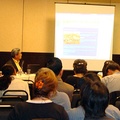Introduction
My presentation is based on field research conducted by the author, with the support of the Japan Foundation (2002), along with UNICAMP-FE, among groups of Brazilian migrant workers in several Japanese cities (Hamamatsu, Toyota, Oizumi, Ota, Toyohashi, and Nagano) and in the Brazilian cities of Londrina, Maringá, and São Paulo. My goal is to show, through changes that have taken place during the course of more than twenty years of migrations, the formation of networks and the role they play in regard to the migrants.
Initially, life for Brazilians in Japan was characterized by their presence in some areas of the country, such as Oizumi, Hamamatsu, and Toyota, where they encountered problems both at work and in their day-to-day affairs due to the glaring social and cultural differences between Japan and Brazil, with clashes occurring between migrants and the local population. In order to face those challenges, the migrants began creating their own workspaces, daily routines, educational and leisure activities, and means of communication (media), while incorporating Japanese cultural influences. These activities produced an exclusive environment for Brazilians, which led not only to a reduction of conflicts with Japanese residents but, most importantly, to the opportunity for the migrants to express themselves in accordance with their cultural background. On the other hand, the Brazilian nuclei helped to exacerbate the separation between the migrants and the Japanese, who, for their part, already displayed a standoffish behavior toward the migrants because of cultural barriers or fear of the unknown.
1. From similar status (dekasegi) to social inequality
At the beginning of the migrations, the Brazilians were employed as laborers in “5K” positions – Kiken (dangerous), Kitanai (dirty), Kitsui (heavy), Kibishii (difficult), and Kirai (despicable) – in which they all considered themselves in comparable work conditions as in Brazil even if they had high professional and educational qualifications there. The foreign workers performed tasks refused by Japanese workers, who generally have high educational and professional qualifications.
In order to satisfy the demands of the growing market of Latin American migrants in Japan, Brazilian businesses – in commercial, manufacturing, educational, technical, and entertainment activities – were established in that country. The expansion of Brazilian businesses led to the success of some entrepreneurs who distinguished themselves from the other migrants in the country, forming a small but wealthy group that employed both Brazilian and Japanese workers. On the other hand, difficulties related to job access, for a variety of reasons, forced a considerable number of migrants into underemployment, unemployment, and even homelessness. This diverse and complex situation became a manifestation of the profound social inequalities that exist in Brazil, though transposed to a country (Japan) that has a greater social and cultural homogeneity among its inhabitants.
2. Formal Networks: Trade, Education, Communications, and Leisure Activities
The complexity of the migrants’ life experiences begins to demand specific needs that cannot be satisfied by the Japanese market – such as those for Brazilian products, food, clothing, schools, Portuguese-language media, leisure activities, among other items of Brazilian origin – thus requiring that Brazilian entrepreneurs set up connections with the producing market. As a result, Brazilian companies begin to extend their activities to Brazil, opening branch offices that complement activities developed in Japan. Manufacturing, commerce, education, media, and leisure requirements sustain suppliers of goods, special equipments, raw materials, etc. In the same manner, companies headquartered in Brazil begin to open branch offices in Japan, with an eye on the migrant market, including tourism, real estate, transportation services, computers, banking, media, and schools. This interaction helps to increase the hiring of professionals specialized in the aforementioned areas, such as journalists, teachers, technicians, and artists. Those formal networks provide the migrants with a dynamic mobility between Brazil and Japan, as they continuously bring and take with them influences of new cultural forms created by Brazilians as they adopt local cultural features into their forms of behavior, while at the same time facilitating the migrants’ settling down in their destination country as a result of the strengthening of their entrepreneurial investments in Japan.
3. Informal Networks: Kinship and Friendship
Family and friend relationships between the migrants and their relatives who remained in Brazil have developed into strong bonds since the beginning of the migratory process. These relationships have served as a support basis enabling the work of the migrant in Japan. Some of the migrants’ family members, including the elderly, and friends were given tasks such as the management of properties and finances, and especially the care of children left behind in Brazil. Through these informal networks, other Brazilians were able to obtain employment in Japan, as well as opportunities to spend their leisure time at the home of relatives and friends in that country.
The changes in the lifestyle of migrant families in Japan, with the (de)construction and reconstruction of their families, culture, and daily routines began to influence those who continued to live in Brazil, reformulating or reversing values that had been traditionally adopted for the organization and functioning of the family. The tradition that the first-born should be responsible for the elderly parents became inverted, once the opposite took place during the course of the migrations; in other words, the migrants had to rely on the support of their elderly parents to take care of their children and other commitments left behind in Brazil. Sometimes, the family networks complemented the formal ones, making them more efficient in regard to the relationships between migrants and non-migrant Brazilians.
Current Perspectives
The transformations that have taken place throughout the migratory process have favored both the population movement between Brazil and Japan and the settling down of migrants in their destination country. The internal networks established within Brazilian communities throughout Japan, as well as the networks between the two countries, have facilitated the movement of migrants in search of new opportunities, in addition to related needs and activities. At the same time, the national and international networks have made possible the option of settling in the country of either destination or origin due to local interests, such as business relations or family ties with the country in question; for instance, children born in Japan or business interests in that country. With the perspective of a global recession as the decade comes to a close, new challenges will require new strategies – no longer individualized ones as before, but of a collective nature, involving government efforts in both countries.
* Lili Kawamura was a panelist in a presentation titled “Dynamic life of migrants between Brazil and Japan—Perspective on Brazil” at a Discover Nikkei Symposium—“100 Years of Japanese Immigration: The Multiple Identities of the Nikkei Community” in Sao Paulo on September 20, 2008.
© 2008 Lili Kawamura




